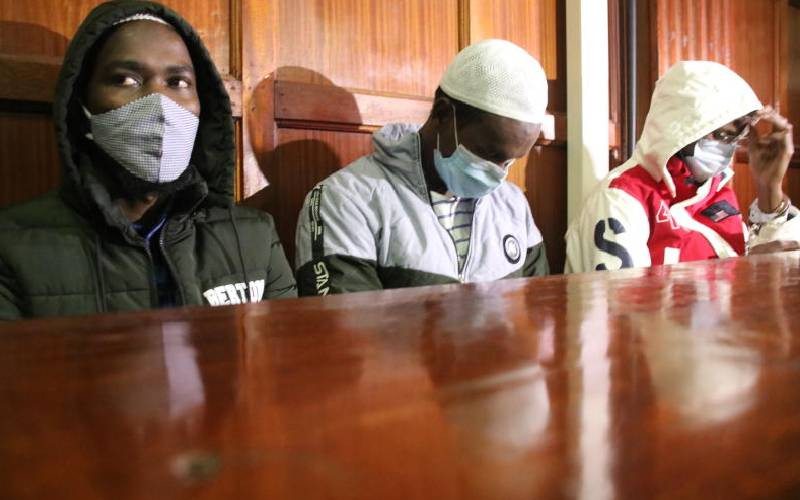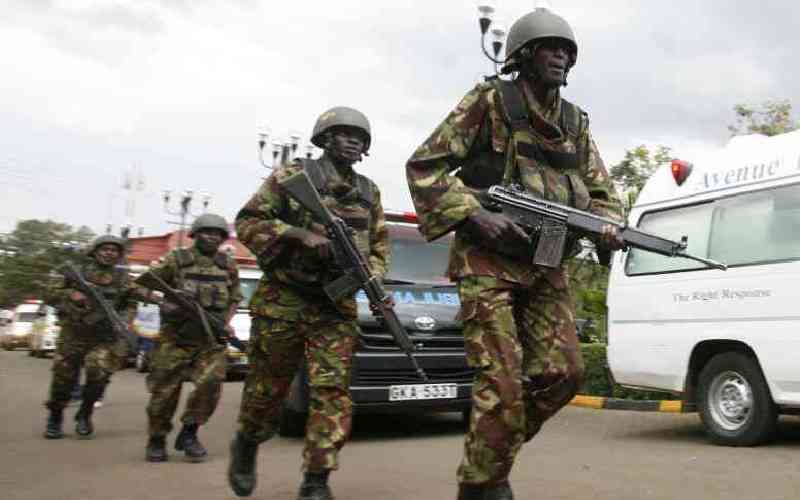 |
|
Interior Minister Joseph ole Lenku addresses the press in Mombasa. [PHOTO: Maarufu Mohamed, Kelvin Karani/STANDARD] |
By The Standard on Sunday Team
Nairobi, Kenya: Investigation into a foiled terror attack in Mombasa last week is now centred on three aspects surrounding a car found with explosives. It is focusing on a one-month policy for which the vehicle was insured, the presumed owner of the KAN 410E Toyota Hilux and the profiles of two suspects from Wajir County, now in detention.
As detectives grapple for clues, the suspects, Abdiaziz Abdillahi Abdi and Isaak Noor Ibrahim, both born in 1988 according to Identity Cards seized from them, are said to be divulging little information to interrogators who are trying to bridge the information gap through background checks on their past and telephone records.
On Monday, police intercepted a vehicle carrying two improvised explosives in Changamwe and arrested two terror suspects. Police say the explosives were connected to a mobile phone and powered by the car battery. Later last week, the two were arraigned in a Mombasa court on seven terror-related charges, including murder.
Investigations by The Standard on Sunday have revealed that Abdiaziz was a cattle trader and renowned navigator of old caravan trade routes based in Garissa town prior to his recent alleged dalliance with Al Shabaab. Noor, investigators say, was a long distance truck driver or conductor who often travelled to South Sudan through Uganda.
Noor reportedly lived in Mombasa’s Bondeni area where he acquired some knowledge of Kiswahili. He drove the weapons-laden car to Mombasa and has immense experience in motor vehicle mechanics. Enquiries in Wajir indicate Abdiaziz is an ethnic Degodia from the Masare clan, who regularly resided in Wajir town, which explains why some local residents dispute the veracity reports that the suspects had Kenyan IDs.
Abdiaziz also completed a two weeks driving course in Mombasa in February, according to intelligence officials, who disclose that there is no evidence that he sought formal employment after this course.
Cell-phone signal
Trackers from the Anti-Terrorist Police Unit (ATPU) told The Standard on Sunday he was most likely the key driver when they began tracking the vehicle from Garissa town on an undisclosed dates in early March.
According to ATPU’s analysis, the car took at least two days to travel from Garissa to Mombasa through Hola and Garsen. There were stops in Hola and Mtwapa, according to this analysis, and the trackers lost the group’s signal around Garsen, but restored it as the car approached Malindi.
The cell-phone signal disappeared after a brief stop at Mtwapa and was restored a few days later at a garage in Changamwe in Mombasa, where the suspected terrorists were unmasked by a police informer. Reports show that Kenya’s intelligence corps had been tracking the two suspects for months when they began communicating with designated Al-Shabaab cell members in rebel held areas of Somalia.
Mombasa County police commander Robert Kitur told The Standard on Sunday “we have been tracking the telephone communication of one of them,” but did not specify which one, although reports indicate it was Noor owing to his cell phone traffic to areas in Somalia’s Dobley and Gedo, where Al Shabaab is still very active.
“We were tracking one of them because he was often communicating with certain people in Somalia,” said Kitur adding that they do not have an indication whether “the explosives and the car were locally assembled.”
According to police records, the car’s licence plate was registered to a Mr Kiprono based in Eldoret. Detectives suspect the plate found with the suspected terrorists was fake, but still want to interrogate Kiprono to determine whether he sold a vehicle or if it had been stolen.
Meanwhile, these records show the car had been insured for a month in Nairobi by an insurer based in the Kenyan capital, but with offices in Mombasa. The policy was issued on February 17, and was to expire on March 16, the latter the presumed date of an alleged terrorist attack on Moi International Airport in Mombasa.
Stay informed. Subscribe to our newsletter
Kitur says Kiprono has not been found so far, but police would like to confirm if he bought this 30 days policy, adding that the latter may provide information regarding the vehicle he allegedly owned before buying the policy.
But Kitur and other officers involved in the investigation acknowledge that interrogating Kiprono might not yield important clues since there was evidence that the vehicle itself could have been assembled from parts cannibalised from different cars, which were either stolen or bought at different places. Reports show the chassis and engine numbers are not compatible.
Lone wolves
The Standard on Sunday has established that Noor and Abdiaziz were part of a larger squad US and Kenyan intelligence and counter-terrorism units had been tracking for close to a month after it left Somalia.
Independent accounts suggest that although the squad left areas around Dobley and Hosingow in southern Somalia, their controllers were based in the Bardheere and Garbahareey areas of south central Somalia, where the US’ Federal Bureau of Investigation (FBI) Communication Intelligence Unit suspect key commanders of Al Shabaab live in impenetrable hills and mountains.
Kenyan officials also suggest that the team that crossed into Kenya could also have been acting as lone wolves, without direct access to top Al Shabaab commanders but still insist they remained a deadly threat given the communication traffic some of them maintained with the commanders.
Kitur has acknowledged that Kenya’s intelligence was aware that nine Al Shabaab operatives had crossed into Kenya from Somalia last month, apparently to commit terror attacks. Officials in Mombasa believe the two suspects in custody were part of the nine-person squad. “We are now pursuing the other suspects,” said Kitur.
A senior intelligence officer told The Standard on Sunday that 11 Al Shabaab militants crossed into Kenya at Mandera and Garissa from Gedo and Dobley areas of Somalia.
“About five went to Nairobi and the rest are thought to be in Mombasa,” the official said, adding that some of the militants were foreign fighters with links to the Yemen-based Al Qaeda in the Arabian Peninsular (AQAP), which is said to have sponsored the foiled plot.
The evidence suggests the militants were acting on the orders or advice of Kenyan fugitive Fuad Abubakar Manswab, who is facing terrorism charges alongside Briton Jermaine Grant, and who jumped bail two years ago.
 The Standard Group Plc is a
multi-media organization with investments in media platforms spanning newspaper
print operations, television, radio broadcasting, digital and online services. The
Standard Group is recognized as a leading multi-media house in Kenya with a key
influence in matters of national and international interest.
The Standard Group Plc is a
multi-media organization with investments in media platforms spanning newspaper
print operations, television, radio broadcasting, digital and online services. The
Standard Group is recognized as a leading multi-media house in Kenya with a key
influence in matters of national and international interest.
 The Standard Group Plc is a
multi-media organization with investments in media platforms spanning newspaper
print operations, television, radio broadcasting, digital and online services. The
Standard Group is recognized as a leading multi-media house in Kenya with a key
influence in matters of national and international interest.
The Standard Group Plc is a
multi-media organization with investments in media platforms spanning newspaper
print operations, television, radio broadcasting, digital and online services. The
Standard Group is recognized as a leading multi-media house in Kenya with a key
influence in matters of national and international interest.









